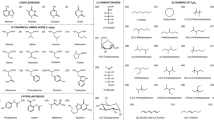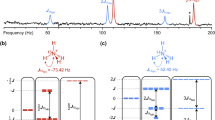Abstract
A NUCLEAR quadrupole resonance signal1 is split into two components by electrostatic fields2 with up to maximum field strengths of 50 kV/cm. The separation between the two components is a linear function2 of the polarizability of the molecular species under investigation. The aim of this communication is to demonstrate the general validity of this particular relationship2 which is in fact independent of any restricting experimental conditions, for example application of an electrostatic field (Stark effect2). Although there are relatively few compounds for which both the nuclear quadrupole resonance and molecular polarizability data are available, the general validity of the correlation between the molecular polarizability and nuclear quadrupole resonance parameters, such as the molecular electric field gradients qzz, can be demonstrated conclusively in the series of the homologous compounds CH3C1, CH2Cl2 and CHCl3. The relevant experimental data3–7 are shown in Table 1 and illustrated in Fig. 1.
This is a preview of subscription content, access via your institution
Access options
Subscribe to this journal
Receive 51 print issues and online access
$199.00 per year
only $3.90 per issue
Buy this article
- Purchase on Springer Link
- Instant access to full article PDF
Prices may be subject to local taxes which are calculated during checkout
Similar content being viewed by others
References
Dehmelt, H. G., and Krüger, H., Naturwissenschaften., 37, 111 (1950).
Duchesne, J., Read, M., and Cornil, P., J. Phys. Chem. Solids, 24, 1338 (1963).
Livingston, R., J. Phys. Chem., 57, 496 (1953).
Gutowsky, H., and McCall, D., J. Chem. Phys., 32, 549 (1960).
Pound, R., and Watkins, G., Prog. Nucl. Phys., 2, 21 (1952).
Livingston, R., Phys. Rev., 82, 289 (1951).
Stuart, H. A., in Die Struktur des Freien Moleküls, 440 (Springer-Verlag, 1952).
Landolt-Börnstein, in Zahlenwerte und Funktionen, 1, Part 3, 515 (Springer-Verlag, 1951).
Gmelin's Handbuch der Anorganischen Chemie, Silicium, eighth ed.
Landolt-Börnstein, Zahlenwerte und Funktionen, 1, Part 2 260 121, 267 (Springer-Verlag, 1951).
Clausius, R., Mechanische Wärmetheorie, 2, 94 (1874).
Mosotti, O. F., Mem. Math. Fis. Modena, 24, Part II, 49 (1850).
Townes, C. H., and Dailey, B. P., J. Chem. Phys., 17, 783 (1949).
Das, T. P., and Hahn, E. L., Solid State Phys., suppl. 1, 101 (1958).
Hückel, W., in Structural Chemistry of Inorganic Compounds, 471 (Elsevier, 1951).
Gerdil, R., Nature, 212, 922 (1966).
Lucken, E. A. C., and Whitehead, M. A., J. Chem. Soc., 2459 (1961).
Iredale, T., Nature, 177, 36 (1956).
Meal, H. C., J. Amer. Chem. Soc., 74, 6121 (1952).
Bray, P. J., and Barnes, R. G., J. Chem. Phys., 22, 1787 (1954); ibid., 27, 551 (1957).
Das, T. P., and Hahn, E. L., Solid State Phys., suppl. 1, 18 (1958).
Author information
Authors and Affiliations
Rights and permissions
About this article
Cite this article
MACHMER, P. Empirical Correlation between the Molecular Electric Field Gradients and the Average Molecular Polarizabilities of some Halogen Compounds. Nature 217, 165–166 (1968). https://doi.org/10.1038/217165a0
Received:
Published:
Issue Date:
DOI: https://doi.org/10.1038/217165a0
Comments
By submitting a comment you agree to abide by our Terms and Community Guidelines. If you find something abusive or that does not comply with our terms or guidelines please flag it as inappropriate.



